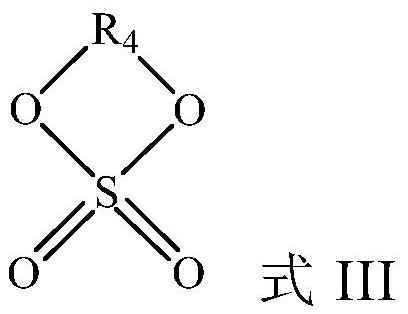Non-aqueous electrolyte and lithium-ion battery
A non-aqueous electrolyte, non-aqueous solvent technology, applied in non-aqueous electrolytes, batteries, electrolytes, etc., can solve problems to be improved, and achieve the effects of improving transfer kinetics, improving overcharge safety, and suppressing side reactions
- Summary
- Abstract
- Description
- Claims
- Application Information
AI Technical Summary
Problems solved by technology
Method used
Image
Examples
Embodiment 1
[0057] (1) Preparation of non-aqueous electrolyte
[0058] Use compound A1 as a non-aqueous solvent, and then dissolve 1mol / L LiPF 6 As a lithium salt, 0.1% DTD is then added to configure a non-aqueous electrolyte.
[0059] (2) Preparation of positive pole piece
[0060] The cathode active material LiNi 0.5 mn 1.5 o 4 , the conductive agent acetylene black, and the binder polyvinylidene fluoride (PVDF) at a weight ratio of 94:3:3 are fully stirred and mixed in the N-methylpyrrolidone solvent system, and then coated on the current collector Al foil and dried. Cold pressing to obtain the positive electrode sheet.
[0061] (3) Preparation of negative pole piece
[0062] Negative electrode active material artificial graphite, conductive agent acetylene black, binder styrene-butadiene rubber, thickener sodium carboxymethyl cellulose in a weight ratio of 95:2:2:1 are fully stirred and mixed in a deionized water solvent system , coated on the current collector Cu foil, dried, ...
PUM
| Property | Measurement | Unit |
|---|---|---|
| flash point | aaaaa | aaaaa |
Abstract
Description
Claims
Application Information
 Login to View More
Login to View More - R&D Engineer
- R&D Manager
- IP Professional
- Industry Leading Data Capabilities
- Powerful AI technology
- Patent DNA Extraction
Browse by: Latest US Patents, China's latest patents, Technical Efficacy Thesaurus, Application Domain, Technology Topic, Popular Technical Reports.
© 2024 PatSnap. All rights reserved.Legal|Privacy policy|Modern Slavery Act Transparency Statement|Sitemap|About US| Contact US: help@patsnap.com










